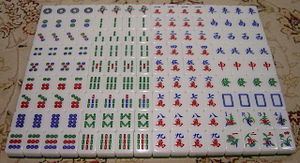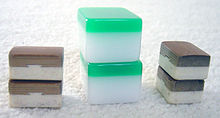- Mahjong tiles
-
Mahjong tiles (麻將牌 or 麻雀牌; Mandarin: májiàngpái; Japanese: mājanpai) are tiles of Chinese origin that are used to play many games, most notably Mahjong and Mahjong solitaire. Although they are most commonly tiles, they may also refer to playing cards with similar contents as well.
Contents
Construction
Traditionally, Mahjong tiles were made of bone, often backed with bamboo. Bone tiles are still available but most modern sets are constructed from various plastics such as bakelite, celluloid, and more recently nylon. There are a small number of sets that have been made with ivory or jade, but these are exceedingly rare: most sets sold as ivory are in fact made from bone. Regardless of the material used to construct the tiles, the symbols on them are almost always engraved or pressed into the material. Some expert players can determine the face value of their tiles without actually looking at them by feeling these engravings with their fingers.
There are generally two size categories available, the larger mainland-China size and the smaller Taiwanese/Japanese/American size. However, within the former category (Mainland Chinese), 4 sizes have been roughly standardized:
- Size 8 ~ 39 × 30 × 23 mm
- Size 7.5 ~ 38 × 28 × 22 mm
- Size 7 ~ 36 × 26 × 21 mm
- Size 6 ~ 34 × 25 × 19 mm
The length/thickness ratio in all of these must be above 1: 1.5, so that the tiles can steadily stand upright, since Chinese players use no racks to support their tiles in hand during play.
The sizes within the second category (Taiwanese/Japanese/American tiles) have lengths that vary roughly between 3 cm (1-5/32") and 2.5 cm (1"). However, the Japanese tiles set themselves apart within this class by virtue of their thickness, which allows them to stand upright—despite their diminutive overall size. This enables Japanese mahjong players also to dispense with the use of racks (these are pervasive in the American game, in combination with slimmer tiles.)
Contents
A set of Mahjong tiles will usually differ from place to place. It usually has at least 136 tiles, most commonly 144, although sets originating from America or Japan will have more.
Mahjong tiles can be organized into several categories:
Suited tiles
The majority of Mahjong tiles are of a rank and a suit. There are three money-based suits of tiles (銅索萬), with ranks ranging from one to nine. There are four tiles of each rank and suit combination, thus there are 36 tiles in a suit, and 108 suited tiles in total. To refer to a suited tile, the rank is named, followed by the suit.
The circle suit (筒子, pinyin tǒngzi (barrel); also 餅/饼, pinyin bǐng (flatbread); Japanese 筒子 romaji pinzu) is represented by a series of circles.









The 1 Circle is generally a large circle of multiple colors, while the rest of the circle tiles consist of smaller circles, each circle being of one color. The 2 Circle consists of a green and a blue circle, the 3 consisting of one blue, one green, and one red circle arranged diagonally (the order the circles appear in, as well as the orientation, differs between sets). The 4 Circle has two blue circles and two green circles, arranged in a rectangle with circles of like color in opposite corners. The 5 Circle is similar to the 4 Circle, with another circle (its color depending on the set) in the middle. The 6 Circle consists of two green circles at the top and four red circles in the bottom (with a space between the green and red circles). The 7 Circle is similar to the 6 Circle, but has 3 green circles arranged diagonally from top-left to bottom-right. The 8 Circle has eight blue circles arranged in a 2x4 rectangle. The 9 Circle has three each of blue, red, and green circles, with each color occupying a row. There is some space between each row, and the middle row is always of the red circles (the blue and green, of course, depends on the orientation of the tile).
Because of the large size of the circle in the 1 Circle, it is commonly nicknamed da bing (大餅 pinyin dàbǐng, lit. big pancake).
From the monetary origin of this suit, the circles represent the copper coins. (1銅=one copper coin).
The bamboo suit (索子, pinyin suǒzi (woven thread); also 條/条, pinyin tiáo (strip); Japanese romaji sōzu), with the exception of the 1 Bamboo, which is represented by a bird, is represented by outlines of sticks.









The 2, 3, 4, 6, and 8 Bamboo are represented entirely out of blue and green sticks, while the middle stick in the 5 Bamboo, the top stick of the seven bamboo, and the sticks along the center column of the 9 Bamboo are red. Some sets may also have the sticks along the bottom row or center column of the 7 Bamboo in blue. The 8 Bamboo has its sticks forming an M-shape and its mirror image.
The 1 Bamboo, as it is often shaped as a bird, is often referred as the sparrow (麻雀 - má què). The rumour why the 1 Bamboo is different from others is to avoid cheaters from adding more Bamboo lines to the 1 Bamboo to change it into other Bamboo tiles.
From the monetary origin of this suit, the sticks are actually rope strings (索) that tie 100 Chinese copper coins together by the square holes in the middle. (1索=100銅) Notice the repeated bumps in the sticks depict the individual coins in the strings, but they were mistaken as the knots on the bamboo plants, hence the English name of the suit.
The character suit , more appropriately known as the WAN Tiles (萬子/万子, pinyin wànzi, Japanese romaji wanzu or manzu) is represented by Chinese characters.









Although some sets use Simplified Chinese characters, many use traditional Chinese characters as they are more complex and considered more aesthetically pleasing. The rank of the tile is represented at the top, in blue, with Chinese numerals, while the character below (萬 wàn, meaning myriad) is in red. Some sets may also have a black Arabic numeral in a top corner, for the benefit of players who are not familiar with Chinese numerals. Some sets use the character 伍 for five instead of 五.
The ones and nines of each suit (幺九, pinyin yāo jiǔ) are collectively referred to as the terminal tiles.
From the monetary origin of this suit, the wans (10,000) are actually 100 strings of coins described in the bamboo suit section above. One myriad equals ten thousand coins or 100 strings of 100 coins. (1萬=100索×100銅)
Honor tiles
Honor Tiles are tiles that do not have a rank or suit. They are divided into two categories, Wind tiles (風牌/风牌, pinyin fēngpái, Japanese romaji kazepai) and Dragon tiles (三元牌, pinyin sānyuánpái, Japanese romaji sangenpai). There are four types of Wind tiles and three types of Dragon tiles, with four of each type of honor tile. Thus, there are 16 wind tiles and 12 Dragon tiles for 28 honor tiles.
The Wind tiles consist of four kinds of tile: East (東, dōng, Japanese romaji ton), South (南, nán, Japanese romaji nan), West (西, xī, Japanese romaji shā), and North (北, běi, Japanese romaji pei).




Each type of Wind tiles corresponds to a point along the compass, written in blue traditional Chinese characters (even for sets where the Character tiles are written in simplified Chinese).
The three types of Dragon tiles are:



- Red (紅中/红中, pinyin hóng zhōng, Japanese 中 romaji chun) - a tile with a red traditional Chinese character (中) or a red dragon. Some sets may also have a black letter C in a corner of the tile, denoting the first letter of the Wade-Giles romanization of 中 (chung).
- Green (青發/青发, pinyin qīng fā, Japanese 發 romaji hatsu) - a tile with a green traditional Chinese character (發), even for sets where the Character tiles are written in simplified Chinese. Often the variant character U+24F35
Wikimedia Foundation. 2010.
Mahjong Titans — A component of Microsoft Windows Details … Wikipedia
Mahjong — For other uses, see Mahjong (disambiguation). Mahjong A game of mahjong being played in Hangzhou, China Chinese name Traditional Chinese … Wikipedia
Mahjong solitaire — A Shanghai solitaire in Turtle formation . The same solitaire … Wikipedia
mahjong — mahjong, Mah Jongg Mah Jongg . A Chinese game played by 4 people with 144 tiles. [WordNet 1.5] … The Collaborative International Dictionary of English
mahjong — Game Mahjong (majiang; also maque [sparrow]) is a popular game normally played by four people using dice and 144 tiles which have numbers and suits the winds, dragons, Chinese characters, bamboo and circles. At the beginning of the game, the… … Encyclopedia of Contemporary Chinese Culture
Mahjong video game — A Mahjong video game is a video game that is based on the classical Chinese game mahjong. However, many mahjong video games, especially among those released in Western territories, do not depict the actual game of mahjong but rather mahjong… … Wikipedia
mahjong — /ˈmaˌdʒɒŋ/ (say mah.jong), / ʒɒŋ/ (say zhong) noun 1. a game of Chinese origin, usually for four persons, with 136 (or sometimes 144) domino like pieces or tiles (marked in suits), counters, and dice. –verb (i) 2. to win a game of mahjong. Also,… …
Tiles of the Dragon — Infobox VG title = Tiles of the Dragon developer = Softdisk publisher = Softdisk released = 1993 genre = modes = Single player ratings = platforms = DOS media = input = Keyboard, Mouse Tiles of the Dragon is mahjong solitaire game for DOS created … Wikipedia
mahjong — mah·jong also mah·jongg (mäʹzhŏngʹ, zhôngʹ) n. A game of Chinese origin usually played by four persons with tiles resembling dominoes and bearing various designs, which are drawn and discarded until one player wins with a hand of four… … Universalium
mahjong — noun /mɑːˈʤɒŋ/ a) A game (originally Chinese) for four players, using a collection of tiles divided into five or six suits. b) A solitaire game using the same tiles … Wiktionary



